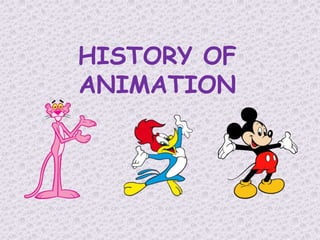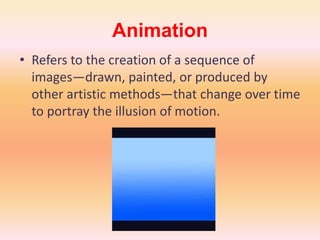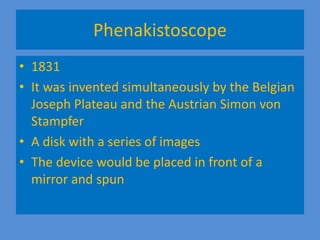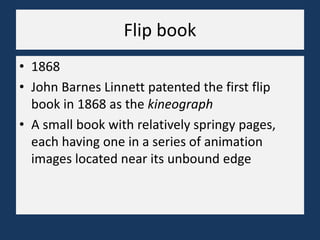History of Animation
- 2. Animation • Refers to the creation of a sequence of images—drawn, painted, or produced by other artistic methods—that change over time to portray the illusion of motion.
- 3. Paleolithic Period • Paleolithic cave paintings • Early attempts to convey motion • Animals with multiple sets of legs in superimposed positions
- 4. The Magic Lantern • c. 1650 • Consisted of a translucent oil painting, a simple lens and a candle or oil lamp • Earliest known example of projected animation • In a darkened room, the image would appear projected onto an adjacent flat surface
- 5. Thaumatrope • 1824 • A small disk with different pictures on each side and is attached to two pieces of string • When the strings are twirled quickly between the fingers, the pictures appear to combine into a single image
- 6. Phenakistoscope • 1831 • It was invented simultaneously by the Belgian Joseph Plateau and the Austrian Simon von Stampfer • A disk with a series of images • The device would be placed in front of a mirror and spun
- 7. Zoetrope • 1834 • The concept was suggested by William George Horner • Cylindrical spinning device • Frames of animation printed on a paper strip placed around the interior circumference
- 8. Flip book • 1868 • John Barnes Linnett patented the first flip book in 1868 as the kineograph • A small book with relatively springy pages, each having one in a series of animation images located near its unbound edge
- 9. Praxinoscope • 1877 • The first known animated projection on a screen • Created in France by Charles-Émile Reynaud • He projected the first animation in public, Pauvre Pierrot
- 10. Humorous Phases of Funny Faces • 1906 • First entirely animated film • Created by J. Stuart Blackton
- 11. Little Nemo • Winsor McCay is the first to use a process called Keyframe Animation in his film Little Nemo
- 12. Gertie the Dinosaur • 1914 • Another film by McCay • First film to combine live action footage with hand drawn animation
- 13. Felix the cat • 1919 • First appears as a silent comedy • Drawn and animated by Otto Mesmer
- 14. Steamboat Willie • 1928 • The first Disney cartoon is released which features synchronised sound effects
- 15. Snow White and the Seven Dwarfs • 1937 • The first ever cel-animated full length, full- colour feature is released by Disney
- 16. Huckleberry Hound • 1958 • Hanna – Barbera released Huckleberry Hound • A blue dog with a relaxed and sweet personality
- 17. Star Trek 2 – The Wrath of Khan • 1980 • First film to use Fractal-Generated Landscapes in its ‘Genesis Effect’ scene
- 18. Jurrasic Park • 1993 • Directed by Steven Spielberg • The film uses animatronics and CGI to create realistic looking dinosaurs
- 19. Toy Story • 1995 • Directed by John Lasseter • Released by Disney Pixar • First ever full-length CG feature film • First theatrical film produced by Pixar
- 20. Final Fantasy: the Spirits Within • 2001 • By Hironobu Sakaguchi • The film is the first to attempt photo-realistic synthetic humans in CG
- 21. AVATAR • 2009 • James Camaron’s Avatar is released by 20th Century Fox • New camera technology is utilised which allows the live acting and motion capture to be viewed – superimposed with CG – in real time
- 22. History of Indian animation YEAR ANIMATION FILM DIRECTED BY 1974 Ek Anek Aur Ekta Vijaya Mulay 1986 Ghayab Aya Suddhasattwa Basu 1992 Ramayana: The Legend of Prince Rama Yugo Sako and Ram Mohan 2005 Hanuman V.G. Samant
- 23. THANK YOU






















